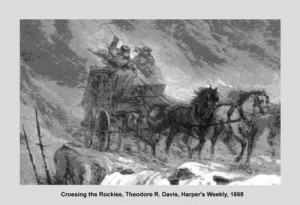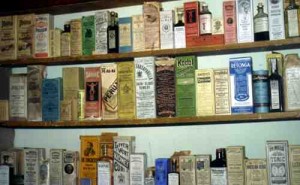Column by George Sibley
Politics – September 2008 – Colorado Central Magazine
IT WAS AN INTERESTING WEEKEND. I spent most of Saturday doing “community stuff,” but of the enjoyable sort (no meetings) — helping set up the Library’s Used Book Sale (highgrading a couple of books); then over to the Farmers’ Market to pass out copies of the new Gunnison Valley Journal, a collection of local writings and pictures I’d helped edit; then back to the Book Sale for another foray (found a brand new John LeCarre I hadn’t read); then back to the Farmers’ Market (via the Gunnison Brewery for a liquid lunch and The Bean for liquid dessert) to help dismantle things; then back to the Book Sale to help pack up the unbought books (free by then, and I found a “Cremation of Sam McGee” for the new grandson)….
It was the kind of day that balances out the “serious stuff” of community life, and is important because it recharges one for the serious stuff.
But the next day, I headed up the valley to beyond Crested Butte for a more private day. After dropping off some Gunnison Valley Journals at the Farmers’ Market there, I went up the Slate River to hike up Oh-Be-Joyful Creek because it’s the closest thing to Iceland I know of around here: a place where the bones of the earth lie close to the surface.
Iceland. Partner Maryo and I spent a few days there this summer, and while I don’t want to move there (just imagining what it’s like in the long dark winter is too much for me), it is a hard place to get out of the mind. I’ve never been in a place where the underlying chaos of creation is so omnipresent. We went to where a new volcano had erupted under a glacier in 1996 — one of the best documented examples of nature destroying itself we’ll ever have. Within a day of that event, helicopters were filming the enlarging hole the eruption of magma had melted up through several hundred feet of compacted ice. By the time enough water had melted under the ice to actually “float” the glacier and run out from under it in a jokullhlaup, the eye of the world was on it, watching an instant quarter-mile-wide river roar out from under the ice, carrying ice lumps the size of buses, which took out the steel-beam bridge of Iceland’s Ring Road as if it were a Tinkertoy and left what today is a denuded plain of cobbles with the “normal” melt-river of a retreating glacier braiding its way through it.
But even where nature’s violence is not so immediate, Iceland is a study in contrasts — that primal rawness side-by-side with spreads of the lushest green beauty imaginable. In search of an excavated 11th century farm, we drove for miles through a blasted barren landscape in the shadow of the active volcano Hekla — only to come into a green little valley with the excavated farmhouse at its mouth. Walking beyond the farm, we found ourselves in an almost magical, steep valley with three waterfalls tumbling into it. Totally temporal: Hekla is right there, and has buried that valley a couple of times since it buried the 11th-century farm.
ICELAND STILL HAS several volcanoes about which they say today, it’s not “if” but “when” they’ll next blow. But they farm on, beautiful green well-watered hayfields with the vivid green rolling right on up to the steep cliffs and hills of volcanic rock. Sheep wander everywhere. And everywhere else, there are waterfalls. After you’ve taken pictures of the first 20 or so, you say, “oh, another waterfall,” and it takes something really unusual to make you stop to photograph yet another one.
The only thing missing is trees. There were birch forests over maybe a fourth of the island when humans first went there, but they soon disappeared — probably an early “energy crisis” — and the climate may have cooled enough by then in Europe’s “Little Ice Age” to preclude them growing back.
The island itself is only some 14 million years old, an upstart compared to the vast North American plate that has been boiling up out of the Mid-Atlantic Rift and creeping westward for hundreds of millions of years. Iceland sits right astride that Rift, a hickey of Rift magma that raised up above sea level to look around and decide what it wanted to be when it grew up: North America or Europe — which plate to move with?
Like humans given such basic choices, Iceland cracked under the pressure. The Mid-Atlantic Rift translates up through the island to a rift valley, about an hour east of Reykjavik, Iceland’s only city. Reykjavik is on the part of the island that is moving westward with the North American plate. East of the rift valley, Iceland is moving eastward with the European plate, and those two halves of Iceland are moving apart at a rate of two centimeters a year, pretty speedy for continental plates. The rift valley itself has sunk several meters over the past thousand years, sinking back into the primordial Ginnungagap of Icelandic mythology.
BUT THE MOST INTERESTING THING about this, to me, was, well, The Thing. Not some cinematic alien Thing, but Iceland’s variation on the old European conceit that we humans could, and probably should, try to govern ourselves, using our own brains rather than waiting for some god or gods to tell us what to do. Their Thing.
Iceland was one of those places, like North America several hundred years later, invaded by Europeans, a place where those who came would have had trouble with the question, whether they were fleeing Europe or advancing it. But one of the northern European institutions the Norsemen who settled Iceland brought with them was the concept of “the Thing,” a kind of an outdoor parliament (outdoors because no one was building buildings that big yet) of people coming to the conclusion that it was better to try to negotiate and wheel and deal before resorting to the old tradition of working things out violently, the way nature does. They realized that devising rules and laws, and submitting to them the way other peoples submitted to a god, gave some spine and dignity to the processes of negotiating, wheeling and dealing. All that, plus a good two-week party, was The Thing.
Scandinavians back home had them; Germans had them (das Ding); even those ornery Danes had them. The Greeks had had something similar a millennium before and called it something we translate as “democracy.” It’s a European thing; you don’t see that kind of thing coming out of the monotheistic desert realms of the Great Billygod of the Burning Bush.
But what does this have to do with geology? Well, the Icelanders chose to hold their annual Thing in that central rift valley, where North America and Europe are tearing Iceland apart: Thingvellir, “the place of the Thing.” For centuries they came together every summer for a couple of weeks in what eventually came to be a kind of country-fair celebration of themselves. Otherwise inbred local clan-groups and villages gathered to check out the girls and boys in inbred local clan-groups and villages; people traded goods, services, ideas, and sons and daughters in an increasingly vital culture — all on a fragile skin of cooled rock atop the most powerful and constantly active manifestation of the earth’s nuclear innards.
THE THING always began with an event that everyone gathered for, on the west side of the valley. There, an elder with a good memory (they hoped he had a good memory) mounted the sloping rock where the valley skin has cracked away from North America heading west, and spoke the law. The Lawspeaker recited what amounted to their constitution. But it was fragile, then as now, fragile as that thin skin of rock it was held on. Sometimes the raw passions of clan honor, vengeance, and maybe even terminal boredom, boiled up over the effort to think through Things, and even at the Thing fighting would break out. Eventually, external pressure and internal disorder led Iceland to slide back to embracing kings, sort of like America today — let some poseur who claims to speak to the gods be above the law and tell us what to do; it’ll be easier.
We think of the Magna Carta in 1297 as being where the idea of a free society of equals begins. But bringing the king back under the law seems to be a reaffirmation of something that has been struggling up to the human surface for centuries in Europe, and still is, I guess, based on our current willingness here, in Lief Erickson’s Vinland, to once again name a king and let him be above the law, after 220 years of a noble effort to do better than that.
And all of this on a skin of cold rock above the primal chaos of earth and fire, water, ice and air, all still trying mindlessly to impose their singular devastations on each other. There is a metaphor for civilization: trying to encrust a layer of civility over the hot passions and inner contradictions of the most versatile mammal.
Can one find any hope in all this? I clamber up the rocks along the edge of Oh-Be-Joyful Creek (where the rock skin is thicker and the waterfalls smaller), alone after a day immersed in the marketplace of a town, perhaps trying to reawaken the spirit of The Thing. Maybe there is hope; I hope so. But whatever, whichever, there is certainly a deep, dynamic (if sometimes sad and terrible) beauty to it all.
George Sibley writes from Gunnison when he’s not in Iceland, where the winters are darker but warmer.


